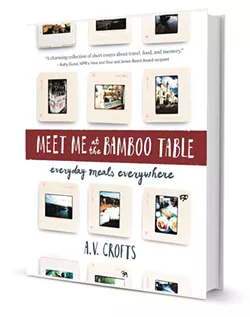For some of us, memory is formed through food. Whether it's your first taste of freshly caught seafood within sight of the water, an unfamiliar dish in a faraway place, or something special cooked by a loved one, food often features in some of our favorite stories.
This was certainly the case for Anita Verna Crofts, author and professor of communications at the University of Washington. Her book Meet Me at the Bamboo Table: Everyday Meals Everywhere is a collection of 21 personal essays spanning meals she's eaten in 15 countries over 40 years of her life.
Food is the connecting point in these stories, but they are really about life. Through them, Crofts explores growing up, life after college (including an enviable trip around the world), relationships, jobs, and the great gift of communicating across cultures. As I read, I felt like I was right there with her (if only the book came with samples of everything she describes).
Beyond Crofts' writing, this book is also visually stunning. Each essay is illustrated by photos from the trip she is describing. For the book's design, she worked closely with Dan Shafer, graphic designer for Chin Music Press, a small independent publisher in Seattle. Shafer had a vision for the project right away.
The first time they met, Crofts recalls, "He said, 'I want this to be the kind of book you can pick up for five minutes or five hours, and either way you'll learn something.'" She continues: "That was my clarion call the entire time I was writing."
Together, Crofts and Shafer went through hundreds of pictures, many of them from long before the days of digital photography. Crofts selected just a few particularly meaningful pictures from each of the 15 countries, and Shafer selected a few that moved him as well.
Since the book's release last October, Crofts has become even more passionate about engaging cross-culturally.
"We are more alike than we are different," she says. "There is so much to be gained and to be learned from having an open heart and an empty stomach ... To me, the book is really meant to reflect the spirit of generosity that I have witnessed, and that I hope to then perpetuate in the way that I cook for others."
Crofts sees food as far more than a way to attend to hunger. Under the right circumstances, it can be a point of connection.
"Meals are more than just sustenance; meals are ways to bridge cultures, to bridge stereotypes, to bridge any negative influences that can too often get us to believe that we don't have common ground," she says.
And for the author, one of the greatest measures of success is when readers find their own stories in hers.
"At a very personal level, what I've loved is when people paw through a page and say, 'It was this passage, this really reminded me of something that happened to me.' ... Even if it's not about them, it's for them." ♦


















